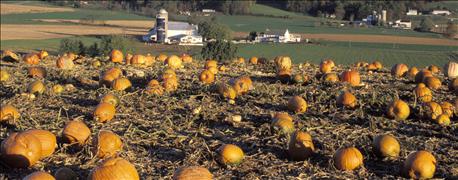October 10, 2016

Predicting frost can be about as difficult as predicting whether your area will be hit by an ice storm. Both depend upon a very narrow range of weather conditions. A slight change in temperature or other conditions one way or the other can determine whether the event occurs or not.
Your grandpa and his pa and grandpa thought they had it figured out. They were pretty confident they could know if a frost was coming. As it turns out, they were often more accurate than you might think. They recognized conditions that produced a certain kind of frost. However, other types of frost are also possible.

TO FROST OR NOT? Would frost likely form on these pumpkins after a day with clear skies and puffy clouds? See what weather scientists say about the possibility. (Photo: Ingram Publishing/Thinkstock)
Here is the brain-teaser question concerning weather this month. The answer is based on the science of weather as we understand it today.
Question: Old-timers say the best time for a frost is when the sky is clear and the wind is still. Is that fact or myth? Why?
Answer: There are different types of frost, but the frost this question refers to is radiation frost. Radiation frost is the kind most people think of when they picture frost at dawn, and is one of the most common forms.
Radiation frost usually forms during clear, calm nights when ground surface heat easily radiates out to space and winds do not mix the coolest air right at the surface. This allows the ground to be several degrees colder than air just a few feet above. Once the surface reaches the frost point, or the air temperature drops below 32 degrees F, frost can form.
At the frost point, ice forms by directly sublimating out of the atmosphere onto the cooled surface. It does not “fall” like rain. So yes, the old-timers are right if they’re talking about a radiation frost.
Other types
It’s also possible for a mass of cold air to collect in a valley or low spot of the terrain. Even though the air temperature immediately above or around the area may be above freezing, the low spot itself may be cold enough to allow frost to form. This frost usually melts once the sun comes up.
There are other types of frost that can form in other conditions dependent on wind, humidity and temperature. Advection frost forms due to blowing cold winds and when ice deposits on the edges of objects like tree branches and other surfaces.
Rime can form when there is fog or high humidity during a cold night. Webster defines "rime" as frost, or granular ice tufts that form on the windward side of exposed objects. Water vapor deposits out of the atmosphere and freezes on outdoor surfaces at the dew or frost point.
Eggert works in the Indiana State Climate Office. He writes from West Lafayette.
You May Also Like




